There are three types of Nikkor lenses that have the focal length of 500mm focal length safely covered for photographers who may require such needs - one is the expensive super tele-zoom lens type which has a very flexible zoom range, another is the conventionally designed Nikkor 500mm telephoto lenses which boasts truly excellent performance as you can find some of best of Nikon optical innovations in those class of lenses but naturally, such extraordinary features and performances also interprets into exotic price tags; however, it is not entirely true to quote the best of Nikkor optic at this specific focal length calls for extraordinary high premium; but the reflex Nikkor lenses may able to answer some of the specific needs of photographers - be it for visual effect or simply on a investment cost but a underlying fact remains, as over the years, surprisingly there are growing number of photographers have chosen reflex Nikkor lenses over pricey super telephoto lenses as Reflex lenses are generally far more compact in size and cheaper in cost than comparing optics at specific focal lengths.
 |
Basically, Refiex-Nikkors employ a combination of mirrors and lens elements based on the catadioptric (mirror-reflex) principle widely used in modern astronomical telescopes. In Reflex-Nikkors the light path is 'folded' by the mirror surfaces, permitting a significant reduction in size and weight as compared to conventional lenses of equivalent focal lengths. Another benefit of Reflex-Nikkor design is the virtual elimination of chromatic aberration, assuring superior sharpness and contrast with all film types and eliminating refocusing in infrared photography. |
Optical Characteristics and their Applications
A 500mm focal length lens can be considered challenging to use. Its 5° angle-of-view encloses the subject tightly within the 35mm frame. With most images taken closer than infinity, only the area on which you focus will be sharp. Sharpness in front of and behind the main point of focus falls off quickly. The effect, while isolating the main subject, can be almost surrealistic; however, as camera-to-subject distance increases, so does depth of field, that is why, this lens is never been an easy lens to handle with. However, surprisingly, Nikon had their 500mm lenses designed as lightweight enough to be used for handheld photography, although the relative narrow angle of view often make them difficult for even panning shots, but they are a very handy lens for still photographic sessions such as scenic, travel and even fashion photography. A good support is almost essential as this focal length often magnifies vibration and hence causing blurry images, a basic form of supplementary support such as monopod, is good when the light level has fallen below the handholdable shutter speeds - in this case, below 1/250 sec. If you need to use smaller apertures for capturing wildlife, scenery or landscapes, a sturdy tripod is always recommended.
Another thing that you need to bear in mind is, other than intentionally to achieve blur imagery, precise focusing is almost a must in order to use this lens effectively Since this lens is often used for shooting action or isolating a subject in wildlife or sometimes used in high action sports photography, pre-focusing can be especially advantageous.
 |
<<< -- -A yearly gathering for International Sport photographers here at Kuala Lumpur is to cover the Malaysian leg of the World 125, 250 and 500 c.c. World Motorcycle Championship and also the World Formula 1 Championship at the Sepang F-1 Circuit. |
As there is no clear definition or restriction of how the lens should be used, interestingly enough, the 500mm can be used as a portrait lens. However, one important portrait technique that you must keep in mind is to focus precisely and maintain stability at all time. With the 500mm, the elimination of background and foreground is immensely powerful for making strong portraits. The 500mm can also be an unusual landscape lens, particularly when dealing with horizons or mountains. The compressed perspective of this focal length results in spectacular images.
 |
|
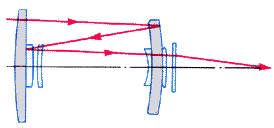 |
A combination of mirrors and lens elements is used in Reflex-Nikkor lenses. Incoming light is reflected twice on mirror surfaces, making the lenses compact and lightweight in Comparison with long telephoto lenses of equivalent focal lengths. Excellent image sharpness is obtained, thanks to the advantages of the reflective light path in suppressing chromatic aberration. Out-of-focus subjects appear as blurred rings or as separated blurred lines. The great advantage of this type of lens is size. Designers can create a lens half the size of its conventionally designed counterpart using the mirror concept. However, the reflex-type lens is restricted to a single aperture (hence, referred as "fixed"); you control exposure with varying shutter speeds or via choice of neutral density filters. |
Take a comparing chart below which uses 500mm as the yardstick, and probably you will understand some truly amazing fact of reflex lenses, even with its fixed aperture which often restrict true creative manipulation of depth of field control, there are still so many serious amateurs and even professionals favor to use this lens as their lightweight traveling companion lens than the comparing bulky true telephoto or super zoom lenses.
|
Comparison of various Nikkor 500mm f/4.0 lenses and the Reflex-Nikkor 500mm f/8.0 |
|||
|
Lenses |
Overall Length |
Telephoto Ratio |
Weight |
| MF Nikkor-P 500mm f/4.0 ED IF |
384mm |
0.768 |
3,000g |
| AF-I Nikkor 500mm f/4.0D ED IF |
370mm |
0.74 |
4,200g |
| AF-S Nikkor 500mm f/4.0D ED IF |
394mm |
0.788 |
3,700g |
| Reflex-Nikkor 500mm f/8.0 |
109mm |
0.212 |
705g |
One of the more interesting results of the catadioptric design is its weight that is only one-third that of a conventional refractive design found in any conventional SLR lens type. Next is the optical characteristic with shapes of out-of-focus highlights which takes on a doughnut or ring appearance that you can effectively incorporate into the overall picture. With any of the reflex Nikkor lenses in the Nikkor lens family, other than using them for static shots, it is important to anticipate the action and pre-focus in many other photographic situations. |
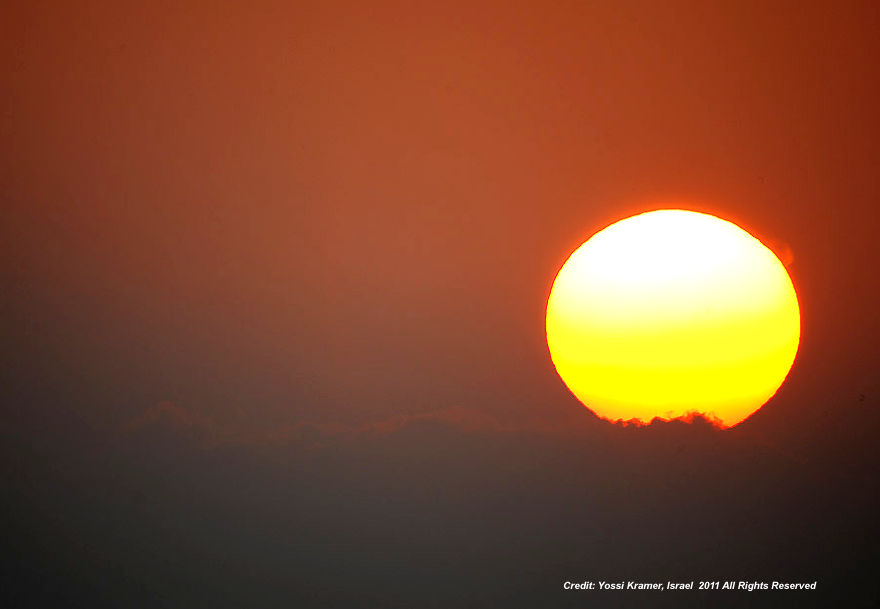 |
<<< -- - A sunset picture taken by Yossi Kramer, Israel <yossikramer@gmail.com> with a 1000mm Reflex Nikkor lens. Pix: © 2011 All Rights Reserved.
Because of the extremely narrower angle of view, coupled with the darker viewfinder image due to the single aperture such as f/8.0, f/11, framing and manual focusing on the action as it actually happens is difficult. A good way to compensate such drawback is to choose a all matte screen type (Brighter screen types such as H2, G2 etc. may not be always a good solution) if your camera is equipped with an interchangeable focusing screen feature.
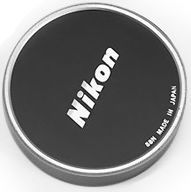 |
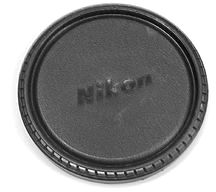 |
Errr ..... frankly, I don't know how much can Nikon save from changing the solid metal front lens cap to the molded plastic type used on the subsequent version. |
However, the MAIN drawback for reflex-type lens is restricted to a single aperture; you can only control exposure with adjustment of shutter speed, changing film types with varying film speed or use an appropriate neutral density filter(s). So it is always a good practice to determine prior to a long journey or working assignment whether Reflex lense is the right kind of lense type for your kind of photography with all the variables present here.
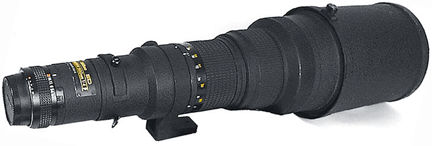 |
A typical Nikkor prime super-telephoto lens such as this 3kg Nikkor 500mm f/4.0P ED-IF lens may also cost 3-4 times than a comparing Reflex Nikkor lens at a same focal length. Its body length is thrice of the reflex lens but it offers 4X gain in its lens speed than a fixed aperture Reflex Nikkor. |
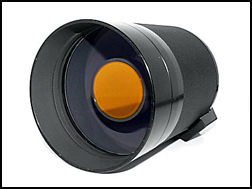 |
Two known early versions of Reflex-Nikkor lenses with remarkable fast lens speed: Mirror-Nikkor 50cm f/5.0 and Mirror-Nikkor 100cm f/6.3 |
Reflex-Nikkor
500mm f/8.0s
|
Non-AI
Reflex-Nikkor 500mm f/8.0
(post-77) |
Non-AI
Reflex-Nikkor 500mm f/8.0
(Pre-AI)
Reflex-Nikkor
1000mm f/11s
| Reflex-Nikkor 1000mm f/11 (Post 77) | Reflex-Nikkor 1000mm f/11 (pre-AI)
Reflex-Nikkor
2000mm f/11s
| Reflex-Nikkor 2000mm f/11 (Post 77) | Reflex-Nikkor 2000mm f/11 (Pre-AI)
EARLY Reflex Nikkor 50cm f/5.0, Reflex-Nikkor 10cm f/6.3
| Message Board |
for
your Nikkor
Optics
in a shared environment
| Message
Board
| Specifically for Dispose or Looking for new/used Nikon/Nikkor
photographic equipment
| Nippon Kogaku Rangefinder Resources | Nikon F | Nikon F2 | Nikon F3 | Nikon F4 | Nikon F5 | Nikon F6 | Nikkormat / Nikomat | Nikon FM Series | Nikon FE/ FA | Nikon EM/FG/FG20 | Nikon Digital SLRs | Nikon - Other models |
Nikon MF RF-Nikkor lenses for Rangefinder
cameras:-
Main Index Page
Nikon
Auto Focus Nikkor lenses:- Main
Index Page
Nikon
Manual
Focus
Nikkor lenses:-
Fisheye-Nikkor Lenses - Circular |
Full Frame |
Ultrawides Lenses - 13mm15mm18mm20mm |
Wideangle Lenses - 24mm28mm35mm |
Standard Lenses - 45mm 50mm 58mm | Telephoto Lenses
- 85mm105mm135mm180mm & 200mm |
Super-Telephoto Lenses - 300mm 400mm 500mm 600mm 800mm 1200mm |
 |
Special Application
lenses: Micro-Nikkor Lenses - 50mm~55mm -60mm 85mm -105mm 200mm Micro-Zoom 70-180mm Perspective Control (PC) - 28mm 35mm PC-Micro 85mm Dedicated Lenses for Nikon F3AF: AF 80mm f/2.8 | AF 200mm f/3.5 EDIF Depth of Field Control (DC): 105mm 135mm Medical Nikkor: 120mm 200mm Reflex-Nikkor Lenses - 500mm 1000mm 2000mm Others: Noct Nikkor | OP-Nikkor | UV Nikkor 55mm 105mm | Focusing Units | Bellows-Nikkor 105mm 135mm Nikon Series E Lenses: 28mm35mm50mm100mm135mm | E-Series Zoom lenses: 36~72mm75~150mm70~210mm |
MF Zoom-Nikkor Lenses: 25~50mm | 28~45mm | 28~50mm | 28~85mm | 35~70mm | 36~72mm E | 35~85mm | 35~105mm | 35~135mm | 35~200mm | 43~86mm | 50~135mm | 50~300mm | 70~210mm E | 75~150mm E | 80~200mm | 85~250mm | 100~300mm | 180~600mm | 200~400mm | 200~600mm | 360~1200mm | 1200~1700mm
Tele-Converters: TC-1 | TC-2 | TC-200 | TC-201 | TC-300 | TC-301 | TC-14 | TC-14A | TC-14B | TC-14C | TC-14E | TC-16 | TC-16A | TC-20E
Recommended links to understand more technical details
related to the Nikkor F-mount and production Serial Number:
http://rick_oleson.tripod.com/index-153.html by: my
friend, Rick Oleson
http://www.zi.ku.dk/personal/lhhansen/photo/fmount.htm by: Hansen,
Lars Holst
http://www.mir.com.my/rb/photography/hardwares/nikonfmount/lens2.htm
http://www.photosynthesis.co.nz/nikon/serialno.html
Recommended Reading Reference on Nikon cameras and Nikkor lenses | about this photographic web site
| | Back | Main Index Page of Nikkor Resources | Back | Main Index Page of Pictorial History of Nikon SLRs |
| Home - Photography in Malaysia |
![]() Co-developed
with my web buddy, Rick Oleson® &
Co-developed
with my web buddy, Rick Oleson® & ![]() Denmark, Creator of the Nikon
Repair Group Mailing-List;
A
contributing effort to Michael Liu's Classic Nikon SLRs and
Nikkor optic site.
Denmark, Creator of the Nikon
Repair Group Mailing-List;
A
contributing effort to Michael Liu's Classic Nikon SLRs and
Nikkor optic site.
Credit: MCLau®, who has helped to rewrite
some of the content appeared this site. Chuck Hester® who has been helping
me all along with the development of all these Nikon websites; Lars Holst Hansen, 'Hawkeye'
who shares the same passion I have; Ms Rissa, Sales manager
from Nikon Corporation Malaysia for granting permission to use some of the official
content; Ted Wengelaar, Holland
who
has helped to provide many useful input relating to older Nikkor lenses; Some of the references
on production serial numbers used in this site were extracted from Roland Vink's website; Hiura Shinsaku from Nikomat
Club Japan. Lastly,
to all the good people who has contributed their own expeience, resources or kind
enough granted permission to use their images of their respective optic in this site.
It is also a site to remember a long
lost friend
on the Net. Note:certain content and
images appeared in this site were either scanned from official marketing leaflets
& brochures published by Nikon and/or contribution from surfers who claimed originality
of their work for educational purposes. The creator of the site will not be responsible
for may discrepancies arise from such dispute except rectifying them after verification. "Nikon", "Nikkormat", "Nippon Kokagu
KK"
& "Nikkor" are registered
tradename of Nikon Corporation Inc., Japan. Site made with an Apple IMac.